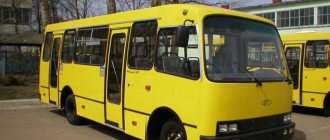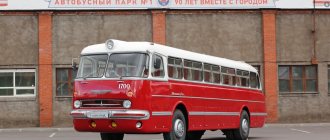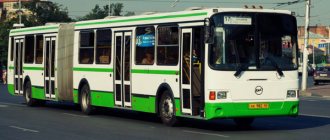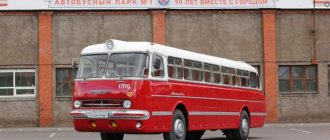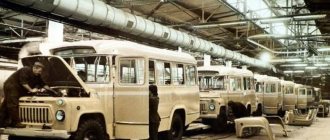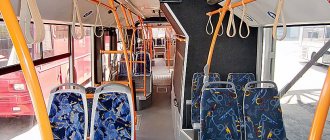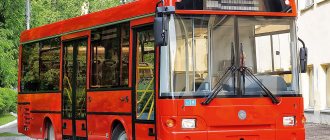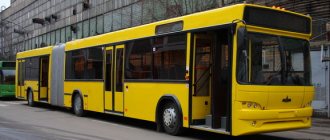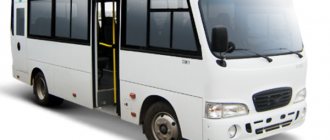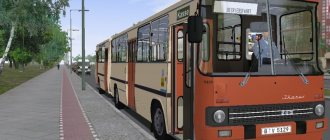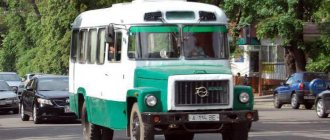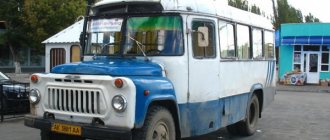According to its technical characteristics, the Hyundai County bus belongs to the intermediate category of passenger cars, located between minibuses and middle-class equipment. The car appeared in the production program of the South Korean plant in 1998, replacing the Chorus model cars, which were descendants of Japanese buses based on Mitsubishi Fuso. Since 2006, the installation of Kauti cars from imported components has been carried out in Russia; in different years, buses have been assembled in Taganrog and Kemerovo.
Economy Hyundai County
Hyundai County is the most economical, due to minimal fuel consumption and a diesel engine. Car maintenance does not require extra investment. If operating standards and rules are strictly followed, the Hyundai County bus will serve for a long time without breakdowns. Increasingly, it is purchased as a minibus. Harmonious design The Hyundai County bus has a modern design. Everything is done as functionally and harmoniously as possible, which makes it stand out from the general stream of city vehicles.
History of the creation of technology
In the 2000s, the number of passenger routes increased sharply, and the requirements for their safety and comfort also increased. The demand for small-sized buses, which would be affordable for small businesses and would pay for themselves on less popular routes, was actively increasing. The county was ideally suited for this task. Compact, maneuverable, affordable and at the same time full-size, with a spacious interior and high ceiling, it was able to compete with the Gazelle and other small class buses.
The bus was developed in 1998 in two versions: standard and extended. The standard model was designed to carry from 15 to 26 seated passengers, the extended model could accommodate 29-30 people. In 2004, the technical characteristics of Hyundai County were brought to new standards of safety and comfort. The updated model rolled off the production lines under the name e-County.
In December 2006, the company moved part of its production facilities to Russia. The bus was assembled at the Taganrog Automobile Plant in four modifications (including with a low floor and air conditioning). After the plant ceased operations, production was moved to the Kemerovo region. Here it was assembled in four capacity options (for 12, 15, 17, 18 people) and three modifications.
County ensures the comfort and safety of passengers
Hyundai County modifications
The Hyundai County bus is produced in 2 possible modifications: 7m (LWB) and 6m (SWB).
It belongs to the small class with a permissible capacity of 18 (+1) to 21 (+7) people. Hyundai hd County has excellent technical characteristics. It is easy to control, maneuverable, reliable and multifunctional. And the relatively low price of Hyundai County allows it to be the best-selling among similar models of equipment. Already as part of the basic configuration there is a good set of options, including: traction control and anti-lock braking systems, tachometer, power steering, mountain brake and fog lights. Heaters allow you to maintain warmth in the cabin during the winter season.
Prices and car analogues
Since production of the bus ceased in 2013, there are no new County cars available at dealers. On the secondary market, the cost of equipment starts from 200 thousand rubles, for this amount you can become the owner of a bus assembled before 2007. The price of cars assembled in 2011-12. and in good technical condition, reaches 950 thousand rubles. Analogues are Kia (Asia) Combi or Toyota Coaster buses. Competitors also include domestic PAZ vehicles, which are large in size and capacity.
Full technical specifications of the Hyundai County bus
| Vehicle make | HYUNDAI COUNTY | |
| Modification | SWB | |
| Vehicle category | M3, bus class | |
| GENERAL CHARACTERISTICS OF THE MACHINE | ||
| Wheel formula / drive wheels | 4 x 2 / rear | |
| Vehicle layout diagram | carriage; engine location – front longitudinal | |
| Body type / number of doors | carriage, single-storey, closed, all-metal, mounted on a frame / 3 (two doors on the starboard side, driver's door on the left side) | |
| For modifications | SWB | |
| class A | class B | |
| Number of seats | 12+1 | 18+1 or 19+1 |
| Passenger capacity, persons | 22 | 18 or 19 |
| Overall dimensions, mm | ||
| -length | 6345 | |
| -width | 2035 | |
| -height | 2710 | |
| Base, mm | 3350 | |
| Front/rear wheel track, mm | 1705 / 1495 | |
| Weight of the equipped vehicle, kg (according to GOST R 52051-2003) | 4300 | 3945 |
| Gross vehicle weight, kg | 5800 | 5223 |
| Total weight attributable to | ||
| — on the front axle, kg | 2850 | 2141 |
| — on the rear axle, kg | 2950 | 3082 |
| Engine | Hyundai motor company (HMC), D4DD, four-stroke diesel, turbocharged and intercooled | |
| number and arrangement of cylinders | 4, in-line | |
| working volume (cm3) | 3907 | |
| compression ratio | 17.5 : 1 | |
| Maximum power, kW (min-1) | 106,6 (2800) | |
| Maximum torque, Nm (min-1) | 392,4 (1600) | |
| Fuel | diesel | |
| Environmental class | 3 | |
| Supply system | pressure fuel injection | |
| Exhaust gas exhaust and neutralization system | one muffler, no neutralization system | |
| Transmission | ||
| Clutch | dry, hydraulically driven | |
| Transmission | mechanical | |
| — number of gears | forward – 5, backward – 1 | |
| Gear ratios | ||
| —I | 5.380 | |
| —II | 3.028 | |
| — III | 1.700 | |
| — IV | 1.000 | |
| -V | 0.722 | |
| — 3.X. | 5.380 | |
| main gear | NYSA, hypoid | |
| - gear ratio | 5.375 | |
| Suspension | ||
| - front | dependent, leaf spring, with hydraulic telescopic shock absorbers, with anti-roll bar | |
| - rear | dependent, leaf spring, with hydraulic telescopic shock absorbers, with anti-roll bar | |
| Steering | HYUNDAI, steering gear type “screw-ball nut-rack-sector”, power steering | |
| Brake systems | ||
| - working | hydraulic dual-circuit drive with division into circuits along the axes, with amplifier, with ABS; all wheel brakes - drum | |
| - spare | each circuit of the service brake system | |
| - parking | transmission brake mechanism with mechanical (cable) drive | |
| - auxiliary | engine brake retarder | |
| Tires | ||
| - size | 225/75 R17.5 | |
| — bearing capacity index | 126/124 | |
| — speed category | M | |
| Preheater: | Liquid pre-heater (autonomous heater) with two heat guns in the cabin | |
| Features: | Satellite system "GLONASS" (by agreement with the customer) | |
Possible faults
County is a reliable workhorse, but it should be borne in mind that South Korean developers could not take into account the diversity of the Russian climate and operating conditions. Some of the problems were eliminated when production was transferred to Russia, but County does have its own weaknesses. The most significant negative factors that accelerate wear and breakage of parts are:
- poor condition of roads;
- low negative temperatures in winter;
- low quality fuel and technical fluids;
- unprofessional maintenance.
The most common malfunctions:
- Deformation of the clutch fork. The main prevention of this unpleasant breakdown is lubrication every 5 thousand km.
- Damage to the gearshift cable. Experienced drivers even prefer to carry one or two such cables with them, so that in case of a breakdown they can fix the problem without stopping the bus.
- Failure of suspension springs. The service life of “native” Korean or Chinese springs is only 35–40 thousand km. They should be replaced with more reliable ones or put up with frequent repairs.
- Failure of anti-roll bars. They need to be changed every 1–2 fuel assemblies. km – the end bushings break. Many people solve this problem by installing “collective farm” silent blocks made from a piece of rubber.
- Vibration and beating of the chassis. In general, the chassis is the weakest point of the County. Some problems can be solved by replacing silent blocks, bushings and other parts, but in general County owners should be prepared for frequent adjustments.
- Deterioration of heat and sound insulation in the first months of operation. This is due to the low quality of the seals, which should be replaced immediately after purchase.
- Low quality paintwork on the body. The “original” paint lasts for one and a half to two years, after which cracks appear, which accelerates corrosion of the body. Ideally, the problems with painting and seals should have been resolved by Russian assemblers, but this did not happen.
- Low resource of aluminum pipelines of the air conditioner and pneumatic system.
- Rapid clogging of the radiator of the engine cooling system.
- Frequent failure of the heater radiator. All these problems can be solved by timely replacement of parts or their careful and frequent maintenance.
The seating arrangement in the cabin has several options.
Of the County's advantages, the engine should definitely be noted. Motors are the least likely to cause complaints from bus owners, especially if you change the oil more often (every 15-20 thousand km, and more often when operating in difficult conditions - every 5-7 thousand km). Also one of the most reliable components is the transmission. The gearbox, crankshaft and drive axle are highly reliable and operate without failure.
Hyundai County minibus equipment
| Standard (NMS) | Standard (RZGA) |
| Forced intake manifold system | Power steering |
| Power steering | Tachometer |
| Wheel covers | Fog lights |
| Tachometer | Mountain brake |
| Radio tape recorder | Front heater |
| Fabric upholstery for passenger seats | Passenger heater |
| Passenger visor | Front sliding door |
| Paul-Laxstrong | Sliding tinted side windows |
| Front folding door | Adjustable steering column |
| Tinted stripe on the windshield | ABS brake system |
| Tinted side sliding windows | Autonomous liquid heater |
| Fire extinguisher | Brake force regulator |
Owner reviews
Before making a purchasing decision, it is worth reading reviews from owners - they often contain information that escaped the authors of reviews. In general, Hyundai County is praised for its ease of operation and repair, reliability, excellent road behavior, while noting minor problems with assembly (unfortunately, typical for domestic cars) and suspension stiffness.
Vasily, Ryazan. We purchased 3 of these buses assembled in Taganrog. For a year and a half of use they have not caused any complaints. Maneuverable, compact, easy to operate. Passengers also like it, especially the soft seats. Very decent sound insulation, especially compared to grooves. The bus is also inexpensive to maintain and there are no problems with purchasing spare parts. In general, it is a worthy choice for a minibus or intercity transportation.
Denis, Omsk. I bought a bus assembled at the Taganrog plant. The bus is not bad in terms of dynamics, but purely city, only for smooth roads. Pros: - excellent visibility, the workplace is more comfortable than on a Gazelle, the steering wheel is clear. The downside is the brakes. With a full cabin it is very difficult to stop going downhill. The engine has never failed in cold weather, pulls well and is not noisy. The bus is ideal for a leisurely ride on smooth roads.
Prices for new and used
Currently, these buses are not produced in Russia, and supplies from South Korea have also almost completely stopped. You can buy a Hyundai County directly through services like Avito and others.
In general, prices for used Russian-assembled Counties are within 600 thousand rubles. It’s easy to find and cheaper: for example, a 2007 bus with 18 seats and a mileage of 300 thousand km will cost 220 thousand rubles. Buses with a ready-made route (“take it and go”) will cost more, 500–600 thousand rubles. A special place on the market is occupied by new buses without any mileage, straight from the South Korean assembly line. Their cost can reach 4–4.5 million rubles, not including customs clearance costs.
Design and ergonomics
Hyundai's design is quite simple and yet attracts attention. There are no sharp edges or corners in the body lines, and the windshield has a slight slope. All this, combined with the original front optics and huge interior glass, gives the County a modern appearance
, making it stand out from most buses that can be seen on our roads.
The ergonomics of the driver's seat are well thought out. The layout of instruments and controls is implemented in such a way that a driver driving a vehicle for 8-10 hours at a time does not experience serious inconvenience. The gear shift lever is easy to move and has a clear lock, and the steering wheel is equipped with a hydraulic booster. The instrument panel is perfectly legible even at a quick glance. The wide windshield and the location of the driver's seat provide good visibility from the cabin, allowing you to fully control the road situation.
Let's highlight the main points:
- Excellent driving position
Accessibility of instruments and controls
Easy gear shift
Sophisticated dashboard
- Large windshield
High passenger seats, upholstered in soft fabric, are quite comfortable and convenient. The salon is equipped with horizontal and vertical handrails. The automatic front door has a sliding design, which, when opened, does not cause inconvenience to bus passengers when the cabin is crowded. There is also a rear manual door and a hatch that can serve as an emergency exit if necessary.
